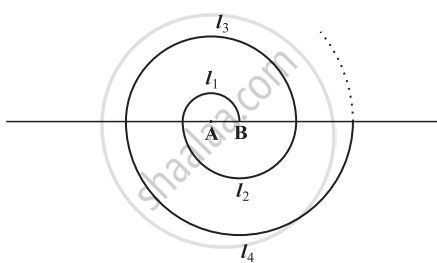Advertisements
Advertisements
प्रश्न
In an A.P. the 10th term is 46 sum of the 5th and 7th term is 52. Find the A.P.
उत्तर
It is given that,
t10 = 46
t5 + t7 = 52
Now,
\[t_n = a + \left( n - 1 \right)d\]
\[ t_{10} = a + \left( 10 - 1 \right)d\]
\[ \Rightarrow 46 = a + 9d\]
\[ \Rightarrow a = 46 - 9d . . . \left( 1 \right)\]
\[ t_5 + t_7 = 52\]
\[ \Rightarrow \left( a + \left( 5 - 1 \right)d \right) + \left( a + \left( 7 - 1 \right)d \right) = 52\]
\[ \Rightarrow a + 4d + a + 6d = 52\]
\[ \Rightarrow 2a + 10d = 52\]
\[ \Rightarrow 2\left( 46 - 9d \right) + 10d = 52 \left( \text { from }\left( 1 \right) \right)\]
\[ \Rightarrow 92 - 18d + 10d = 52\]
\[ \Rightarrow 92 - 8d = 52\]
\[ \Rightarrow 8d = 92 - 52\]
\[ \Rightarrow 8d = 40\]
\[ \Rightarrow d = 5\]
\[ \Rightarrow a = 46 - 9\left( 5 \right) \left( \text { from }\left( 1 \right) \right)\]
\[ \Rightarrow a = 46 - 45\]
\[ \Rightarrow a = 1\]
Hence, the given A.P. is 1, 6, 11, 16, ....
APPEARS IN
संबंधित प्रश्न
Find the sum of the following APs.
`1/15, 1/12, 1/10`, ......, to 11 terms.
In an AP given an = 4, d = 2, Sn = −14, find n and a.
A spiral is made up of successive semicircles, with centres alternately at A and B, starting with centre at A of radii 0.5, 1.0 cm, 1.5 cm, 2.0 cm, .... as shown in figure. What is the total length of such a spiral made up of thirteen consecutive semicircles? (Take `pi = 22/7`)

[Hint: Length of successive semicircles is l1, l2, l3, l4, ... with centres at A, B, A, B, ... respectively.]
If the ratio of the sum of the first n terms of two A.Ps is (7n + 1) : (4n + 27), then find the ratio of their 9th terms.
If (m + 1)th term of an A.P is twice the (n + 1)th term, prove that (3m + 1)th term is twice the (m + n + 1)th term.
If the nth term of the A.P. 9, 7, 5, ... is same as the nth term of the A.P. 15, 12, 9, ... find n.
Three numbers are in A.P. If the sum of these numbers is 27 and the product 648, find the numbers.
Find the sum of the following arithmetic progressions:
3, 9/2, 6, 15/2, ... to 25 terms
Find the sum of the following arithmetic progressions:
a + b, a − b, a − 3b, ... to 22 terms
The sum of n natural numbers is 5n2 + 4n. Find its 8th term.
Which term of the AP ` 5/6 , 1 , 1 1/6 , 1 1/3` , ................ is 3 ?
Draw a triangle PQR in which QR = 6 cm, PQ = 5 cm and times the corresponding sides of ΔPQR?
Write an A.P. whose first term is a and common difference is d in the following.
a = –3, d = 0
Let Sn denote the sum of n terms of an A.P. whose first term is a. If the common difference d is given by d = Sn − kSn−1 + Sn−2, then k =
Q.1
Find the sum of natural numbers between 1 to 140, which are divisible by 4.
Activity: Natural numbers between 1 to 140 divisible by 4 are, 4, 8, 12, 16,......, 136
Here d = 4, therefore this sequence is an A.P.
a = 4, d = 4, tn = 136, Sn = ?
tn = a + (n – 1)d
`square` = 4 + (n – 1) × 4
`square` = (n – 1) × 4
n = `square`
Now,
Sn = `"n"/2["a" + "t"_"n"]`
Sn = 17 × `square`
Sn = `square`
Therefore, the sum of natural numbers between 1 to 140, which are divisible by 4 is `square`.
The sum of all odd integers between 2 and 100 divisible by 3 is ______.
Which term of the AP: –2, –7, –12,... will be –77? Find the sum of this AP upto the term –77.
Find the sum of first 25 terms of the A.P. whose nth term is given by an = 5 + 6n. Also, find the ratio of 20th term to 45th term.
The nth term of an A.P. is 6n + 4. The sum of its first 2 terms is ______.
